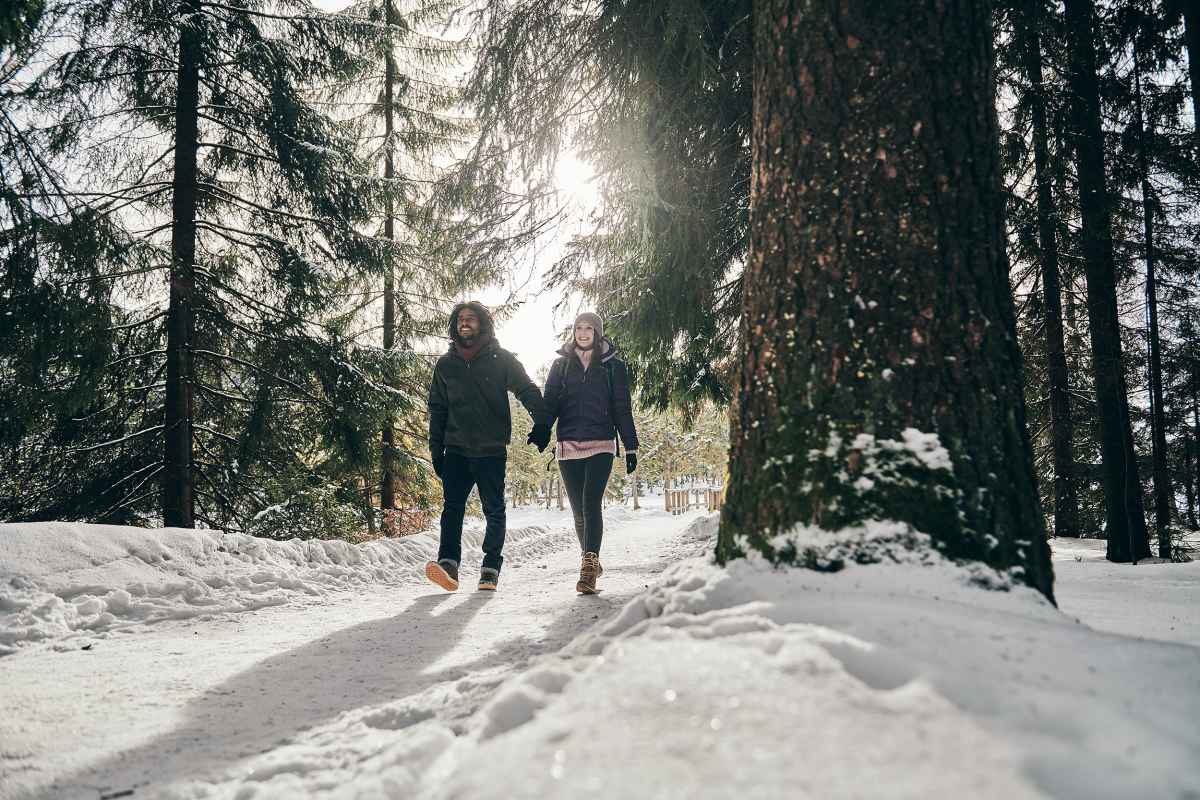In addition to wearing the right clothing, you will need to have good shoes for your next winter stroll. You should keep the following points in mind:
Walking in a winter wonderland Walking in a Winterwonderland.

Cosying up on the sofa under your favourite blanket and sipping a hot, spiced punch or baking cookies with the entire family – many people like to stay comfortably tucked inside their warm homes once winter sets in. There is certainly much to experience and discover as well. Anyone who wants to set off on a stroll during the winter should keep a few small things in mind. We have compiled some of these helpful tips for you.

Equipment tip Footprints in the snow
-
Material
During your stroll, you will probably encounter snow or rain. For this reason, your shoes should be waterproof and be equipped with such features as a GORE-TEX membrane. -
Insulation
You have to live with a certain amount of cold when exploring nature during the winter. To prevent your feet from freezing, your shoes should be well insulated and possibly be lined as well (with a material like wool). You can also use fur insoles or wear thick wool socks. -
Upper Height
As we all know, snow can pile up high. When you set off on a winter stroll, it is helpful to wear shoes that extend to your ankles at least. -
Sole profile
You should wear shoes whose soles have a good tread profile. This will give you the grip you need to walk on winter paths.

Take a breather Rest and enjoy
There is one other point you should keep in mind: You should adjust your breaks to the cool temperatures. The body cools off quickly in the cold. For this reason, we recommend that you take several short breaks instead of one extended timeout. This will keep your body at a fairly constant “operating temperature”. Of course, you should always take breaks during your walk. The cold air and snow-covered paths or streets frequently make strolls more difficult. For this reason, you must pay particular attention to your body and not overdo it.
Tip:
Remember to take along a seat cushion or some other object that you can sit on. This will enable you to take a breather virtually anywhere and ignore the snowy or icy benches.

Short days, long nights Base your stroll on the amount of sunshine available each day
During the winter, lighting conditions change along with the temperature. When you plan your stroll, you have to remind yourself that the days are shorter during this season. The sun comes up later and sets earlier. To prevent a short day from sneaking up on you, you should carefully plan your walk with as much detail as possible. You should take along a torch or headlamp if you go for a walk during the latter parts of the afternoon, for example, to help drivers to see you. You should also wear light-coloured clothing so that you can be seen in the dark.
Extra tip: The sky is frequently very clear during the winter, and you should be able to see several constellations of stars.

The right clothing A different type of “layer system”
Selecting the right clothing is another important aspect of your winter stroll. People frequently make the mistake of overdressing. Once you set off, you will soon begin to sweat. Your clothes will frequently become wet and will dry only very slowly in the cold winter weather. For this reason, you should apply a multi-layer system of clothing. You simply wear different layers of clothing that you can take off if you start to sweat.
-
The first layer
We recommend that you wear light thermal underwear as the first layer. This layer will capture moisture and transport it to the outside. -
The second layer
The second layer produces a pleasant blanket of warmth and prevents the cold from penetrating further. Wool sweaters or fleece jackets are the recommended clothing of choice. Depending on the weather and your personal preference, you may want to wear multiple layers. If you do so, you should make sure that the first layer is thinner than the subsequent layers. -
The third layer
Finally, you should wear a waterproof outdoor jacket and, if necessary, hiking pants. This layer will protect you from snow, rain and wind.
